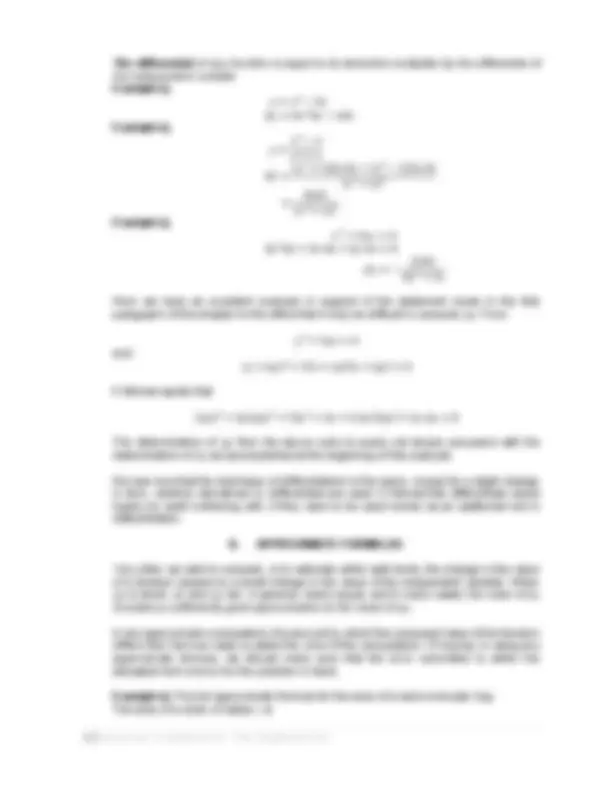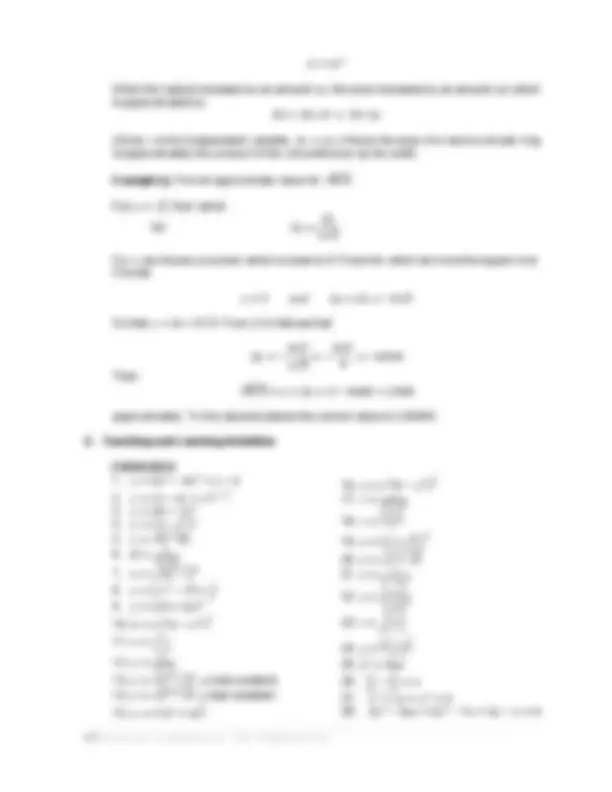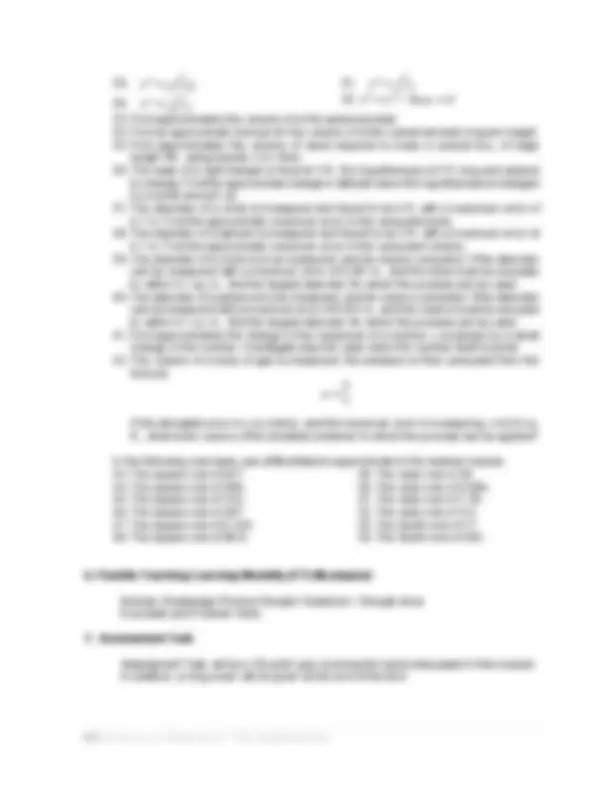





Study with the several resources on Docsity

Earn points by helping other students or get them with a premium plan


Prepare for your exams
Study with the several resources on Docsity

Earn points to download
Earn points by helping other students or get them with a premium plan
Community
Ask the community for help and clear up your study doubts
Discover the best universities in your country according to Docsity users
Free resources
Download our free guides on studying techniques, anxiety management strategies, and thesis advice from Docsity tutors
To understand calculus better and at best.
Typology: Exercises
1 / 6

This page cannot be seen from the preview
Don't miss anything!




Republic of the Philippines
Echague, Isabela
At the end of the discussion, the student should be able to:
Consider an interval in which a curve relating 𝑥 and 𝑦 has a slope 𝑦’. Let 𝑃: (𝑥, 𝑦) be a
point on the curve, as shown in Figures 1 and 2. A change ∆𝑥 in the value of 𝑥 changes
y by some amount ∆𝑦. In the Figures 𝑃’ is the point (𝑥 + ∆𝑥, 𝑦 + ∆𝑦); ∆𝑦 is the distance
𝑄𝑃’. Unless the equation of the curve is particularly simple, it may be difficult to compute
∆𝑦. We seek for ∆𝑦 an approximation which must satisfy two requirements: First it must
be possible for us to prove that the difference between the approximation and ∆𝑦 can be
made arbitrarily small by taking ∆𝑥 sufficiently small; second, the approximation must be
easy to compute.
In Figure 1 and Figure 2, the tangent line at 𝑃 intersects the ordinate through 𝑃’ at the
point 𝑅. Examination of the figures shows that it is plausible that the length 𝑄𝑅 is an
Figure 1 Figure 2
approximation to 𝑄𝑃’ = 𝛥𝑦 for small 𝛥𝑥. Let us see whether 𝑄𝑅 satisfies our two
requirements.
At 𝑃, the slope of the curve is
ொோ
ொ
. Now 𝑃𝑄 = ∆𝑥, so that we obtain
e
We already know how easy it is to compute the slope y’. Hence our second requirement
is satisfied by 𝑄𝑅.
The difference between 𝑄𝑅 and 𝑄𝑃’ is given by
ᇱ
ᇱ
ᇱ
Our first requirement demands that we show that 𝑃’𝑅 → 0 as ∆𝑥 → 0.
We shall do even better by showing that
ᇲ
ோ
∆௫
→ 0 as ∆𝑥 → 0. Indeed,
e
Lim
∆௫→
ᇱ
= Lim
∆௫→
ᇱ
ᇱ
ᇱ
because
Lim
∆௫→
since we are working in an interval where the slope exists. In a sense (2) shows that
𝑃’𝑅 → 0 more rapidly than ∆𝑥 → 0.
The quantity 𝑄𝑅 is called the differential of 𝑦 and is denoted by 𝑑𝑦.
By equation (1)
Theoretically, we are still at liberty to define dx – i.e., the differential of the independent
variable – in any way we please. But if in (3) we put
ᇱ
the result is
Thus, in order to avoid conflict when (3) is applied to the function y=x, we adopt (4) as
our definition. That is, the differential of the independent variable is equal to the increment
of that variable.
We may therefore write
ᇱ
and state the definition as follows:
ଶ
When the radius increases by an amount ∆𝑟, the area increases by an amount ∆𝐴 which
is approximated by
(Since 𝑟 is the independent variable, 𝑑𝑟 = ∆𝑟.) Hence the area of a narrow circular ring
is approximately the product of the circumference by the width.
Example (). Find an approximate value for √8.
Put 𝑦 = √
𝑥, from which
For 𝑥 we choose a number which is close to 8.73 and for which we know the square root.
Choose
So that 𝑥 + 𝑑𝑥 = 8.73. From (1) it follows that
Then
approximately. To five decimal places the correct value is 2.95466.
ସ
ଷ
ସ
ି
య
మ
ସ
ହ
ଶ
ଷ
√ଵିଶఈ
ଶ
ଵ
ଷ
ଷ
ଵ
௧
మ
ସ
ଶ
ଶ
భ
మ
௩
య
௩ ା ଶ
௧
మ
√
ଵ ି ௧
ଶ
ଶ
, 𝑎 held constant.
ଶ
ଶ
, 𝑥 held constant.
ଶ
ଶ
య
మ
ଶ
ଶ
భ
మ
௦
√ଵ ି ௦
మ
√ଵି௦
మ
௦
ସ
௧
(ଶିଷ௧ )
ర
(ଵି௫ )
మ
(ଵିଶ௫ )
మ
ଵ – ௦
ଵ ା ௦
൫௫
య
ି ௫൯
మ
௫ ା ଵ
ଶ
௫
మ
మ
௬
మ
మ
ଶ
ଶ
ଶ
ଶ
ଶ
௫
మ
௫
మ
ି
మ
ଶ
௫
య
ଶ ି ௫
ଷ
௫
మ
ି ௫
ଷ
ଷ
length 6ft., using boards ½ in. thick.
to change. Find the approximate change in altitude when the hypothenuse is changed
by a small amount ∆ℎ.
0.1 in. Find the approximate maximum error in the computed area.
0.1 in. Find the approximate maximum error in the computed volume.
can be measured with a maximum error of 0.001 in., and the area must be accurate
to within 0.1 sq. in., find the largest diameter for which the process can be used.
can be measured with a maximum error of 0.001 in., and the volume must be accurate
to within 0.1 cu. in., find the largest diameter for which the process can be used.
change in the number. Investigate also the case when the number itself is small.
formula
If the allowable error in 𝑝 is 0.001𝑘, and the maximum error in measuring 𝑣 is 0.6 cu.
ft., what is the volume of the smallest container to which the process can be applied?
In the following exercises, use differentials to approximate to the desired number.
Module, Messenger Rooms/ Google Classroom / Google docs
Exercises and Problem Sets.
Assessment Task will be a 30-point quiz covering the topics discussed in this module.
In addition, a long exam will be given at the end of the term